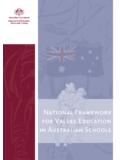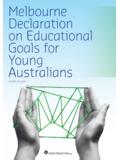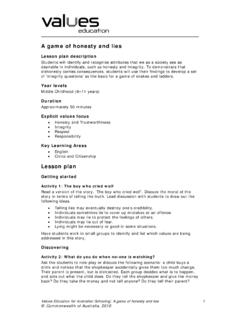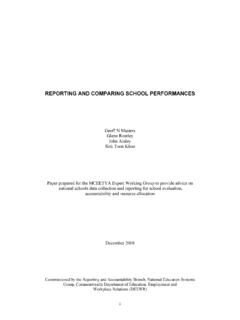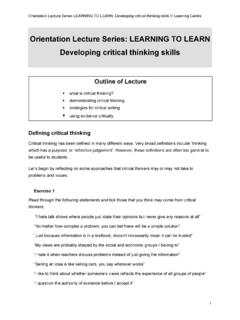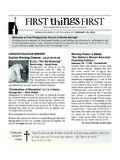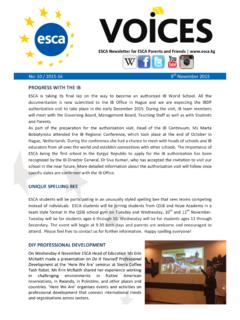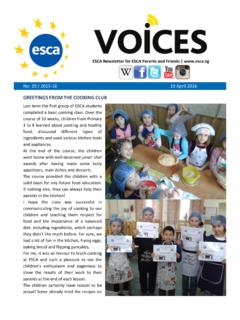Transcription of Readers Theatre using an indonesian folktale
1 Readers Theatre using an indonesian folktale Primary Lesson Plan Return to lesson plans CurriculumPress Catalogue Access Asia free Lesson Plans This lesson plan was developed by Curriculum Corporation. Source Access Asia: Primary Teaching and Learning Units ISBN 1 86366 345 2 Learning area The Arts (drama) Level Middle and upper primary Description Students read a short play based on the indonesian folktale Cicak and Kancil and complete related activities. Purpose To introduce students to Readers Theatre and indonesian folktales . Duration One hour Possible outcomes In relation to The Arts a curriculum profile for Australian schools, this lesson can contribute to outcomes in all strand organisers.
2 Materials required A class set of the handout Cicak and Kancil (from below ) Procedure 1. Teacher's preparation The following points comprise the conventions of Readers Theatre : The script is read rather than recited. Each actor stays in the same spot instead of moving around the stage. Readers Theatre using an indonesian folktale Page 1 of 5 It is more interesting if the actors use movements, actions, gestures and expressive voices. Simple costumes and props are used, such as a hat or cloak. Other props may be mimed. The actors are positioned in an interesting way on the stage, at different levels and angles to complement their roles.
3 Do not just put your characters in a straight line. The characters do not move around or face each other. They may step forward or back but they always face the audience. For a journey they walk on the spot. The characters should always have a focus point in the audience or just above it. Actors move between roles, so that the reading is shared. The following basic props are useful but not essential: percussion instruments cut-out palm trees and houses a camera with flash The cut-out houses and palm trees can be made by students in advance. It would also be useful to have symbols to be held or worn by students playing the roles of the two animals: Cicak and Kancil.
4 Cicak is a lizard we know as a gecko. It has sticky pads on its toes that enable it to run upside down on ceilings and walls. Kancil is a small animal like a deer, but the size of a dog. If you do not have props, students can be asked to make sound effects and use appropriate mime gestures to portray the animals. 2. Introduction Explain to students that they are going to read a short play based on an indonesian folktale . It will be necessary to ensure that students understand the meaning of the indonesian words cicak and kancil. The word bemo is also used. A bemo is a small indonesian pick-up truck with benches in the back so that it can be used like a small bus.
5 Choose five students to begin playing the roles in Cicak and Kancil. Initially, you may take the role of the narrator yourself. The roles are Narrator, Kancil, Cicak, Cicak Number Two and Cicak Number Three. Select additional students to work with props and sound effects. 3. The play Give each student a copy of Cicak and Kancil and arrange the actors in a suitable way on the stage or at the front of the classroom. Then begin the reading, introducing students to the conventions of Readers Theatre as necessary. Try to encourage actors to be animated. Move students between roles from time to time.
6 It will probably be worthwhile to read the play more than once. In the script, ** indicates a suitable place for music or sound effects. 4. Discussion and written work After the reading, use the following questions as the basis for discussion and writing tasks: What characteristics do cicaks and kancils seem to have? How does it feel to play the role of a cicak or a kancil? Readers Theatre using an indonesian folktale Page 2 of 5 Did students expect the play to end in the way it did? What factors affect the quality of the reading? How can it be improved? Does the story have a moral and, if so, what is it?
7 Extension activities 1. A local script Ask students to think of a pair of animals that live in their geographical area and write a similar script about those animals. Ensure that students' work ends with an explanatory sentence similar to that in Cicak and Kancil. Make props and perform the scripts. 2. The wayang Use Access Asia: Primary Teaching and Learning Units or other resources to investigate indonesian wayang plays. Acknowledgements Access Asia: Primary Teaching and Learning Units is part of the Access Asia series, funded by the Commonwealth Department of Education, Science and Training through the Asia Education Foundation.
8 Related resources Hegarty, M. & Stephens, M. 1995, Images, Curriculum Corporation, Carlton, Vic. Watson, R. 1995, Visions, Curriculum Corporation, Carlton, Vic. Handout Cicak and Kancil Narrator: This is a story about Cicak and Kancil. Cicak is a gecko. A gecko is a type of lizard with sticky pads on its toes. Kancil is a small animal like a deer but only the size of a dog. One day, Kancil was resting in his house. He was fast asleep when Cicak, the gecko, tried to catch a spider on the wall. Cicak jumped. ** Cicak missed the spider ** and knocked a picture down.
9 The picture hit Kancil on the head. ** Kancil: Ow! You stupid Cicak! Look what you've done! Cicak: Oh Kancil, I'm sorry to disturb you. If you hadn't been so big and slow you could have moved out of the way in time. Kancil: Slow! Me! I'll have you know I'm much faster than you, Cicak. Your silly legs couldn't run fast at all. Cicak: I'm not slow! I'm sure I'm much faster than you could ever be. Kancil: All right then. I challenge you to a race to prove who is the fastest. We will race to the big mango tree and back here at sunrise tomorrow. The winner will have the right to do anything he likes to the loser, even kill him!
10 ** (drumroll) Do you agree? Cicak: Oh, oh, um. Yes, yes I do. Readers Theatre using an indonesian folktale Page 3 of 5 Narrator: Kancil went off to rub coconut oil into his legs and to rest for the night. But Cicak was in a state of panic. ** Cicak: Oh, dear. What have I done? Kancil is much faster than me. If he wins he will probably kill me. ** I must think. (He walks up and down.) I've got an idea! ** I'll get my friends to help me. Narrator: First Cicak called one friend, ** then another. ** They decided to trick Kancil by hiding along the track of the race, so that instead of one cicak, three cicaks would run parts of the race like a relay.


